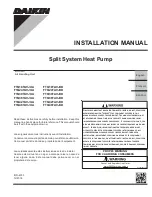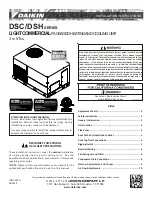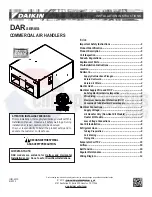
4
Minor field modifications are necessary to convert to downflow
or horizontal right as indicated in below sections.
6.1 Upflow Installation
No field modifications are mandatory; however, to obtain
maximum efficiency, the horizontal drip shield, side drain pan
and drain pan extension can be removed.
Side Drain Pan and Extension Removal: Refer to Figure 1, re-
move the two (2) screws that secure the drip shield support
brackets to the condensate collectors (front and back). Un-
snap the side drain pan from the main drain pan using a screw
driver or any small lever. The side drain pan, drip shield brack-
ets and the drain pan extension may now be removed. From
Figure 1, drain port labeled (A) is the primary drain for this
application and condensate drain line must be attached to
this drain port. Drain port (a) is for the secondary drain line (if
used).
Drip Pan
Extension
Side
Drain
Pan
Screw
B
b
A
Main Drain Pan
Drip Shield Bracket
Drip Shield
P n
a
SIDE DRAIN PAN REMOVAL
Figure 1
6.2 Horizontal Left Installation
No field modifications are permissible for this application.
The bottom right drain connection is the primary drain for
this application and condensate drain line must be attached
to this drain connection. The top connection of the three drain
connections on the drain pan must remain plugged for this
application. The bottom left drain connection is for the sec-
ondary drain line (if used).
In applications where the air handler is installed in the hori-
zontal left position, and the return air environment see hu-
midity levels above 65% relative humidity coupled with total
external static levels above 0.5” e.s.p., a condensate kit is
available for field application. Kit nomenclature can be found
in Table 1.
CMK0008
Condensate
Kit
CMK0009
Condensate
Kit
CMK0010
Condensate
Kit
CMK0012
Condensate
Kit
CMK0013
Condensate
Kit
CMK0014
Condensate
Kit
AVPTC25B14 AVPTC29B14 AVPTC31C14 AVPTC49D14 AVPTC33C14 AVPTC49C14
AVPTC37B14 AVPTC37C14 AVPTC61D14 AVPTC39C14
AVPTC37D14
AVPTC59C14
AVPTC59D14
CONDENSATE KIT
TABLE 1
6.3 Downflow/Horizontal Right Installation
IMPORTANT NOTE:
In the downflow application, to prevent
coil pan “sweating”, a downflow kit (DFK) is available through
your local Goodman distributor. The DFK is not supplied with
the air handler and is required by Goodman on all downflow
installations. See
Table 2
for the correct DFK and follow the
instructions provided for installation.
DFK-B
Downflow Kit
DFK-C
Downflow Kit
DFK-D
Downflow Kit
AVPTC25B14**
AVPTC31C14**
AVPTC37D14**
AVPTC29B14**
AVPTC37C14**
AVPTC49D14**
AVPTC35B14**
AVPTC59C14**
AVPTC59D14**
AVPTC37B14**
AVPTC33C14**
AVPTC61D14**
AVPTC39C14**
AVPTC49C14**
MODEL LIST FOR DOWNFLOW KITS
DOWNFLOW KIT
TABLE 2
Refer to Figure 6 and 7 for the location of the components
referenced in the following steps.
1. Before inverting the air handler, remove blower access panel
and coil access panel. The coil access panel and tubing panel
may remain screwed together during this procedure. Re-
move and retain the seven (7) screws securing the coil ac-
cess panel to the cabinet and the six (6) screws securing the
blower access panel to the cabinet.
2. Slide the coil assembly out using the drain pan to pull the
assembly from the cabinet.
NOTE: DO NOT USE MANIFOLDS OR FLOWRATOR TO PULL
THE COIL ASSEMBLY OUT. FAILURE TO DO SO MAY RESULT
IN BRAZE JOINT DAMAGE AND LEAKS.
3. Removal of the center support is required on units with 21"
wide cabinet. Remove and retain the two (2) screws that
secure the center support to the cabinet. Remove the cen-
ter support.
4. Using the drain pan to hold the coil assembly, slide the coil
assembly back into the cabinet on the downflow brackets as
shown in Figure 8.
5. Re-install the center support (if removed) using the two (2)
screws removed in Step 4.
6. Re-install the access panels removed in Step 1 as shown in
Figure 9.


































